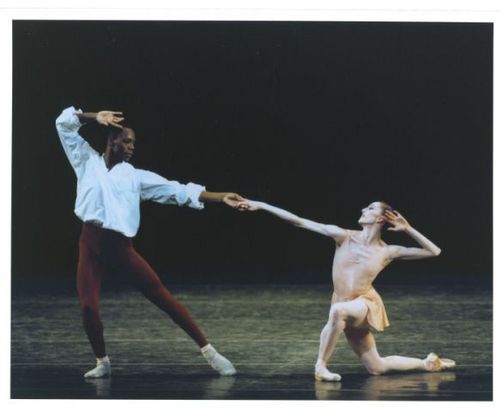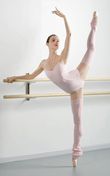But the ordeal did get me thinking more seriously about Hannibal Lecter and Goldberg—and remember I wasn’t on Vicodin so this line of thought was more lucid than you might expect. I was thinking about how Hannibal Lecter is a symbol of hyper-intellectualism. His effete and discerning tastes are given as proof of his lack of humanity; his extreme rationality is a source of his chilly
By choosing to choreograph to the Goldberg Variations, and to use almost all of the musical repeats (something most concert pianists do not do; and Glenn Gould does not do so in his famous recordings of the piece) Robbins was making a statement. Clearly, he felt he had the requisite maturity to tackle such a score. Robbins, who was in his fifties at the time, was coming off the success of what many consider to be his masterpiece: Dances at a Gathering (1969). Dances is another very long ballet, but during its creation Balanchine famously told Robbins that he should keep adding to it. Conversely, Balanchine told Robbins that Goldberg should be pared down (and he did end up cutting a few sections).
In all the biographies it is clear that Robbins, a notoriously self-conscious man, was particularly uneasy about his talents and his legacy at this time of his life. He worried that his successes on Broadway had been too shallow and glib, and he wanted to succeed in ballet because he felt it was a higher art form. But then he worried that ballet was too gentile and that he was forsaking his Jewishness by focusing on it. He worried that he was a hack compared to Balanchine, and he was ashamed by his lack of a college degree, etc. During our Goldberg dress rehearsal I asked ballet mistress Susan Hendl—who originated a lead role in the ballet—about the creation of Goldberg and she said it was hard work for Jerry. She said that it took two years to choreograph and that he was very frustrated during the process. She said emphatically, “it did not come easily to him.” Robbins ignored what he knew about dramaturgy and showmanship with Goldberg, he wanted to make a challenging, audaciously cerebral work. And Robbins apparently did not sufficiently exorcise these demons with Goldberg, for he stubbornly followed Goldberg with Watermill, an hour-long piece in which nearly nothing happens. We hardly ever perform it.
But apparently, Robbins was pleased with Goldberg in the end. In Deborah Jowitt’s thorough biography of Robbins, she explains that initially he was plagued by doubts but, she writes, “[t]hree and a half years later…he had grown fond of it. It had become, he said, the work he was most proud of.” I too feel proud to dance Goldberg (when not distracted by dental maladies, of course) even though it feels tedious at times. I think it is one of those works of art, like T.S. Eliot’s The Waste Land, or James Joyce’s Ulysses, that has something to prove and is therefore often deliberately difficult going, but is ultimately quite beautiful and moving.
I asked several people who came to see Goldberg in the past few weeks how they liked it and if it felt overlong. I got a wide range of answers. In general, the audience response was positive, but most people felt it could be cut by fifteen or twenty minutes. When I asked which areas should be cut the answers were all over the place. Several people thought there was an awful lot of walking around, and they were right. There are three pieces in the first half of the ballet that consist almost entirely of walking: one is called Pavane, one is called Taffy, and one is aptly named Walking. Actually, Taffy is so long it is split into three parts: Opening Taffy, Middle Taffy, and End Taffy.
Another funny aspect of the ballet is that there is a dance called Highlights—in which the entire cast of the first half reprises the best moments of the ballet up to that point—about only a third of the way in. As you can see, Robbins was not shy about the length. Goldberg is one of those ballets for which we post the order of the dances on the booms in the wings in case we forget what comes next. Oddly enough my boyfriend, who makes action movies for a living, has always loved it. (But after he saw Watermill he told me calmly but sternly that he would never in his life sit through it again!)
More than with other ballets, I think that one’s receptivity to The Goldberg Variations is heavily influenced by one’s mood. I just read Bruce Bawer’s essay on Karl Ove Knausgaard, “Life Itself,” in the current issue of the Hudson Review and it too made me think of Goldberg. (At least I’ve stopped mentally linking the ballet to serial killers.) Knausgaard’s autobiographical novel, My Struggle, runs six volumes and several thousand pages. I read the first volume of My Struggle this summer and I toggled back and forth between exasperation, annoyance, and enthrallment as its non-story unfolded. After I finished it I wondered if I’d ever pick up another volume, but then about a month ago the winter chill made me crave more bleak Norwegian nothingness!
Brawer, with what seems a healthy dose of incredulity, remarks that “[o]ne critic after another has proffered the paradoxical-sounding observation that even when Knausgaard is boring, he’s fascinatingly boring.” I feel like Robbins’ Goldberg is much the same. You may not always be in the mood for something so laborious, but there is no denying that even when it is slow, Goldberg is a marvel of structure and musicality. Brawer mentions that Zadie Smith wrote in the New York Review of Books that “Knausgaard’s boredom is baroque.” Well, with The Goldberg Varitaions, Robbins’ boredom is quite literally baroque!


 RSS Feed
RSS Feed